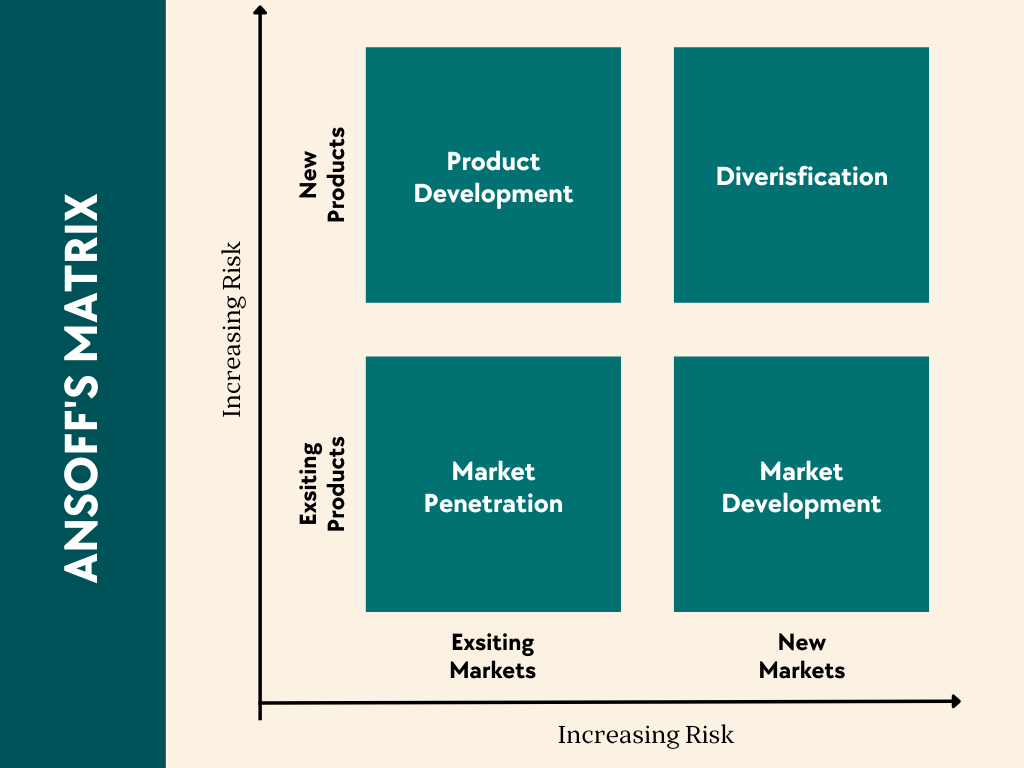In today’s fast-paced and dynamic business environment, companies constantly seek ways to expand and grow. One of the foundational tools for strategic planning and growth is the Ansoff Matrix. Developed by Igor Ansoff in 1957, this matrix provides a framework for businesses to analyze and plan their growth strategies. It’s a timeless tool that helps companies navigate the complexities of market expansion and diversification. In this blog, we will delve into the Ansoff Matrix and explore how it can be applied to drive business growth.
Ansoff Matrix Analysis
To effectively apply the Ansoff Matrix, companies must consider various factors and conduct a thorough analysis:
- Market Research
Understanding the current market and customer behavior is crucial. Market research helps in identifying potential areas for growth and gauging the feasibility of each strategy.
- Resource Assessment
Companies need to evaluate their resources, including finances, human capital, and technology, to determine which strategy is viable. Diversification, for example, typically requires substantial resources and carries higher risks.
- Risk Analysis
Each quadrant of the Ansoff Matrix comes with its own level of risk. Market penetration is relatively low risk, while diversification is high risk. Companies should assess their risk tolerance and ability to manage uncertainties.
- Competitive Landscape
Analyzing the competitive environment is essential. Market penetration may involve intense competition, while diversification can lead to entering unfamiliar competitive spaces.
- Alignment with Core Competencies
Companies should assess whether their existing strengths and capabilities align with the chosen growth strategy. Leveraging core competencies can increase the chances of success.
Ansoff Matrix Case Studies
Let’s explore how some well-known companies have successfully employed the Ansoff Matrix:
- Apple Inc.: Apple’s market development strategy was evident when they expanded into China. By tapping into a new geographic market with their existing product (i.e., iPhones), they achieved substantial growth.
- Amazon: Amazon has employed both market development and product development strategies. Amazon Web Services (AWS) was a product development move that leveraged their existing customer base and infrastructure. Additionally, they’ve continuously entered new markets, such as acquiring Whole Foods to enter the grocery retail industry.
- Procter & Gamble (P&G): P&G’s strength lies in product development. They frequently launch new variations of existing products in response to consumer preferences, maintaining their market share in various consumer goods categories.
Learn more: What is Ansoff Matrix?
Advantages of Ansoff Matrix
The Ansoff Matrix offers several advantages for businesses and strategic planners:
- Structured Approach: The Ansoff Matrix provides a clear and structured framework for considering growth options. It categorizes growth strategies into four distinct directions, making it easier for businesses to evaluate their options systematically.
- Diverse Strategy Selection: It offers a range of growth strategies, from low-risk options like market penetration to high-risk options like diversification. This allows businesses to select strategies that align with their risk tolerance and growth objectives.
- Focus on Core Competencies: The matrix encourages companies to leverage their existing strengths and resources. Market penetration and product development strategies are often built upon the company’s core competencies, which can minimize the need for significant changes or additional resources.
- Market and Product Clarity: By explicitly separating market-related strategies from product-related strategies, the Ansoff Matrix helps companies clarify their growth direction and identify the primary area for strategic focus.
- Risk Assessment: It helps in evaluating the relative risk associated with each growth strategy. This is particularly important when making decisions about diversification, as it can highlight the potential risks and challenges involved in entering entirely new markets or industries.
- Long-Term Planning: The matrix is not limited to short-term planning. It can be used for both short-term and long-term strategic planning, making it a versatile tool for businesses with different time horizons.
- Competitive Analysis: Businesses can use the matrix to assess their competitive position within their current market and make informed decisions on how to gain a competitive edge.
- Holistic Perspective: The Ansoff Matrix encourages businesses to consider their entire product and market portfolio, facilitating a more holistic perspective on growth and diversification.
- Communication and Alignment: It provides a common language and visual representation that can help align team members and stakeholders in discussing and understanding growth strategies.
- Flexibility: The framework can be adapted to suit the specific needs and goals of a company. It doesn’t prescribe a one-size-fits-all solution but rather offers a range of options to choose from.
It’s important to note that while the Ansoff Matrix is a valuable tool, it’s not without limitations. For instance, it doesn’t address all aspects of strategic planning, such as competitive analysis, resource allocation, or execution. Therefore, it should be used in conjunction with other strategic planning tools and a comprehensive strategic planning process to create a well-rounded strategy for a business.
Learn more: What is a RACI Matrix?
Most Recent Posts
Explore the latest innovation insights and trends with our recent blog posts.













